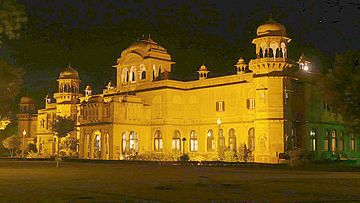Lalgarh Palace & Sadul Museum
Lalgarh Palace, Bikaner – 334001
Phone : +91 151 2540201

Lalgarh Palace was built between 1902 and 1926 according to Rajput, Mughal and European architectural styles, being largely in the Indo- Saracenic style. The building was commissioned by the British -controlled regency for Maharaja Ganga Singh (1881–1942) while he was still in his minority as they considered the existing Junagarh Palace unsuitable for a modern monarch. Ganga Singh decided that the palace should be named in memory of his father Maharaja Lall singh.
In 1972, Karni Singh, M.P., the Maharaja of Bikaner, established the Ganga Singhji Charitable Trust. The Maharaja endowed a part of Lallgarh Palace to be used in service of the trust. Two wings were converted into independent hotels with the income from The Lallgarh Palace Hotel, a heritage hotel used to support the trust. Currently, Lallgarh Palace is owned, and the hotel is run, by his daughter Princess Rajyashree Kumari.
Architecture
The complex was designed by the British architect Sir Samuel Swinton Jacob. After a ritual blessing ceremony construction commenced in 1896 on empty land 5 miles from the existing Junagarh Fort on what is now Dr. Karni Singhji Road. The palace was arranged around two courtyards with the first and most impressive wing, Laxmi Niwas completed in 1902. The remaining three wings were completed in stages with final completion of the complex accomplished in 1926. Lord Curzon was the palace’s first notable guest. Ganga Singh was legendary for his shikars (hunts) at his hunting preserve at Gajner, in particular his Imperial Sand Grouse hunts at Christmas. As a result, the palace hosted many guests including Georges Clemenceau in 1920, Queen Mary, King George V, Lord Harding and Lord Irwin.
The palace was originally designed to cost 100,000 rupees due to the planned use of cheaper materials including the suggestion of using stucco instead of carved stone in the construction. Soon however all cost-cutting was abandoned and by time of the completion of the first wing the cost had increased to 1 million rupees[5] due to the use of the finest materials including the widespread employment of finely carved stonework.
The three-storey complex is coated in red sandstone quarried from the Thar Desert. The complex contains the features considered essential for a late 19th-century palace: drawing rooms, smoking rooms, guest suites, several grand halls, lounges, cupolas, pavilions, including a dining room which could seat 400 diners. The complex features magnificent pillars, elaborate fireplaces, Italian colonnades and intricate latticework and filigree work. The Karni Niwas wing houses the darbar hall and an art deco indoor swimming pool.
Overview
At present the palace houses the following:
The Shri Sadul Museum which is located in the west wing which also contains the fourth largest private library in the world. The museum is open from 10:00 AM to 5:00 PM on all weekdays except on Sunday.
In one wing the private home of the Bikaner Royal Family.
The Lallgarh Palace Hotel. This is a Heritage hotel is owned and operated by the Maharaja Ganga Singh Ji Trust and marketed by Maharaja Heritage Resorts Limited under a Franchise and Marketing Services Agreement.
The Laxmi Niwas Palace. This is a luxury hotel, owned by Golden Triangle Fort & Palace P. Ltd.
Source : Wikipedia
https://www.youtube.com/watch?v=XYf_yomQUqI
https://www.youtube.com/watch?v=D3OKyLUa6L8
Reviews

The Sadul Museum of Bikaner is housed inside Lalgarh Palace. The museum is a store house of some of the most amazing collections of artwork, history and sculptures. The museum is divided into numerous sections thus dividing the available artifacts as per their hierarchy and historical importance.
Inside the museum, at the entrance, one railway coach ( meter gauge ) used by Maharaja and their family members is displayed. A vast collection of Georgian paintings, artefacts, photographs and hunting trophies are put on display for tourists in the gallery. Moreover, the museum has separate section dedicated to each king displaying their life and heroic deeds.
Reviews
Visiting hours : 10.00AM to 05.00PM, all days of the week
Entry fee : Rs.10/- for Indians and Rs.25/- for foreign tourists


Rate this article